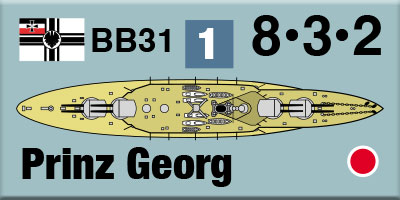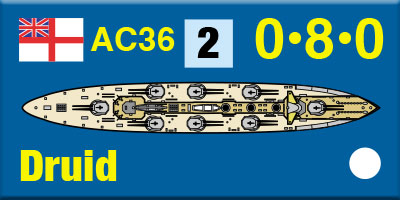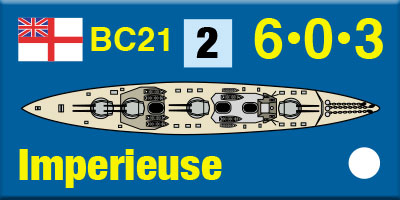From High Seas Fleet to Risk Fleet
by Mike Bennighof, Ph.D.
September 2024
 Ten years ago, we released an expansion for Great War at Sea: Jutland, called High Seas Fleet. I built it around a simple historical premise: Your college history books were wrong. There never was a “dreadnought race” between Britain and Germany before the First World War. There was a marketing campaign by the Vickers-Armstrong shipbuilding combine to create a threat that could only be answered by more spending on more dreadnoughts. Ten years ago, we released an expansion for Great War at Sea: Jutland, called High Seas Fleet. I built it around a simple historical premise: Your college history books were wrong. There never was a “dreadnought race” between Britain and Germany before the First World War. There was a marketing campaign by the Vickers-Armstrong shipbuilding combine to create a threat that could only be answered by more spending on more dreadnoughts.
That’s not some alternative-history starting point. That’s what the facts make quite clear. There was no race, except for profit. And we showed that in High Seas Fleet. But what if there had been such a race? That’s the question at the heart of the book. We show you the ships that Germany could have built, given an application of her financial and industrial muscle to such an effort.
Why did she not do so? Imperial Germany had few nation-wide taxes; it was a federal state and most money was raised and spent at the province/kingdom level. The High Seas Fleet was primarily funded by an excise tax on beer and tobacco. Building more dreadnoughts meant asking the everyday German to pay more for his or her beer and cigarettes. And so, Germany dropped out of the dreadnought race before it happened.
When Jutland moved to its Second Edition, High Seas Fleet needed an update to keep pace. The update became so extensive, that we gave it a new title, Risk Fleet. So what made the changes so extensive as to rate a new title?

An alternative to Seydlitz, with all turrets on the centerline.
The old High Seas Fleet set included 22 pieces for ships that appear in Jutland, but have since had their rating updated (Jutland 2e already reflects this in its ship data). They’ll appear in the new Great War at Sea: Far Side of the World, or in Golden Journal No. 57: Coast Defenders. I didn’t see any reason to repeat them in Risk Fleet. That freed up 22 spaces for new ships.
First, though, the remaining 48 all got new artwork. The process we use to craft die-cut and silky-smooth pieces, without the Marianas Trench smashed into them on the flipside, also includes very crisp reproduction and vibrant color. The old art just doesn’t stand up to scrutiny, not by me anyway, so all of it had to go.

This would have been the 1912 dreadnought, had a class been authorized.
Among the 70 total pieces, then, there are 49 Germans, 20 British and one Australian. This maximal High Seas Fleet is built on the basis of one new class of dreadnoughts in every fiscal year (initially five ships per class, dropping to four as they ships become much larger and much, much more expensive), and two battle cruisers. That means adding ships to the early classes (three dreadnought classes and every battle cruiser class save one). And then we insert new classes, because Germany did not build heavy ships in every fiscal year: one class of of semi-dreadnoughts, three of dreadnoughts, three of battle cruisers and one of armored cruisers.
Daily Content includes no AI-generated content or third-party ads. We work hard to keep it that way, and that’s a lot of work. You can help us keep things that way with your gift through this link right here.
The British get to respond, but since Britain already built dreadnoughts at a pace much closer to her own capacity, there aren’t as many: extra ships for a few classes, two new classes of battle cruiser, and a number of foreign purchases. I also replaced some of the British ships in the old High Seas Fleet set, with ships I thought more interesting.

The Germans expected the British to build an improved armored cruiser in 1906.
I wished to avoid any insertion of fantasy into the new fleets. Since we’re using Risk Fleet to illustrate a thesis (that there was no “dreadnought race,” as Germany could have built many more ships), the book has to stick to ships either actually built (with additional members of the class added in Risk Fleet), actually designed, or at the very least actually proposed and sketched.
Those additional ships, even offset by some additional British construction and purchases, change the balance of power in the North Sea, and therefore would likely have changed the strategic outlook for the High Seas Fleet. In this environment, the German command does not have to hope for the very unlikely matchup of their entire battle fleet with just one squadron or so of the British Grand Fleet. The British actually made this mistake in December 1914, but the Germans fumbled their chance (this is seen in the scenario book, Jutland: North Sea 1914).

The Kaiser himself proposed this ship in 1903.
The High Seas Fleet scenario set no longer matched that of Risk Fleet anyway, but I dug more deeply into it because of this change in the dreadnought ratio (a much-studied number in both Whitehall and the Admiralität). It’s even more favorable to the Germans in Risk Fleet than it was in High Seas Fleet (overall, the British still have an edge - just not nearly so much of one). As displayed in Risk Fleet, the Germans have the firepower to stand up to the British, or at least come much closer than in reality. They can even afford to leave behind some of their very vulnerable older ships.
In the Risk Fleet scenarios, the Germans are much more aggressive. They do not fear battle with the British, and are ready to carry out the Risk Fleet concept: to present such a challenge that the British will not wish to fight them. But Alfred von Tirpitz, author of the Risk Theory, mis-understood his opponent. The Royal Navy is not afraid of Germans, in the real world or any alternative one. If the Germans come out seeking battle, the British are going to oblige them.

Sir Philip Watts proposed this alternative to 1908’s Indefatigable.
Some of the old High Seas Fleet scenarios did not carry over; they called for ships no longer in the set. Many new ones took their place, and filled the pages previously given over to advertising and special rules (those rules are now part of the Second Edition series rules). Risk Fleet has 39 scenarios: 12 operational scenarios, and 27 battle scenarios.
Risk Fleet is the kind of counter-factual history I love to explore in wargame format. It’s not an alternative history: it’s an answer to the question of what a German High Seas Fleet might have looked like had the so-called “dreadnought race” been an actual thing and not a scheme cooked up by the Vickers-Armstrong armaments combine to sell more battleships. Had those claims been real, the fleet presented in our book is the one they would have faced across the North Sea during the First World War. And a German fleet able to match the British ship-for-ship makes for a very different naval campaign.
You can order Risk Fleet right here.
Beyond Jutland
Risk Fleet
Journal No. 38: Alternative Dreadnoughts
Retail Price: $54.98
Package Price: $45.00
Gold Club Price: $36.00
You can journey Beyond Jutland right here.
Sign up for our newsletter right here. Your info will never be sold or transferred; we'll just use it to update you on new games and new offers.
Mike Bennighof is president of Avalanche Press and holds a doctorate in history from Emory University. A Fulbright Scholar and NASA Journalist in Space finalist, he has published a great many books, games and articles on historical subjects; people are saying that some of them are actually good.
He lives in Birmingham, Alabama with his wife, three children, and his new puppy. His Iron Dog, Leopold, was a good dog.
Daily Content includes no AI-generated content or third-party ads. We work hard to keep it that way, and that’s a lot of work. You can help us keep things that way with your gift through this link right here.
|
